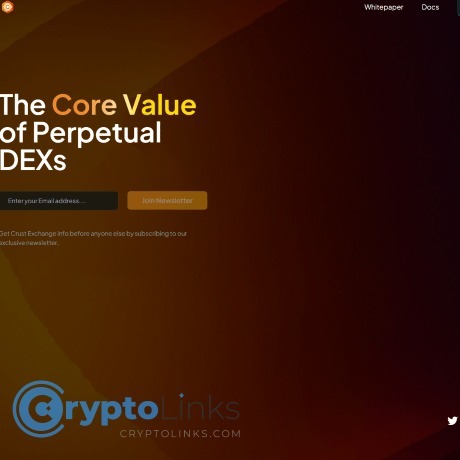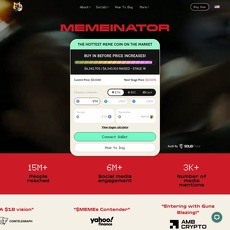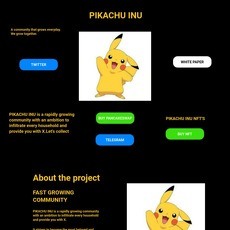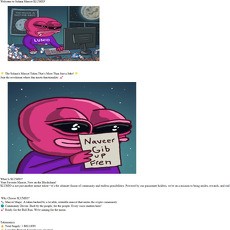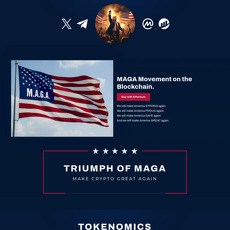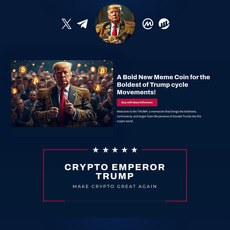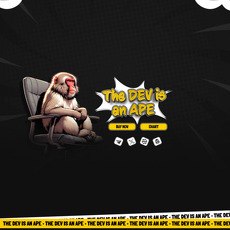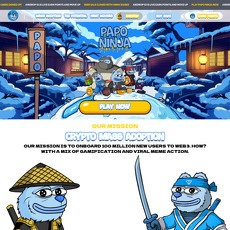Crust Exchange Review
Crust Exchange
crustexchange.io
If your website is on the scam list and you think that you are not a scammer, contact us. After you provide us with all the proof that you are in Crypto World with good intentions, we will delist you. Usually, you get in this category because you are hiding your team, you have a bad reputation(you are tricking, deceiving, scamming people), and you haven't got a written project whitepaper or is a shitty one....
Their Official site text:
What is Crust Exchange?
Introduction
The concept of a reliable, lucrative, and secure financial protocol for investors
After carefully reviewing hundreds of Defi initiatives over the past few months to ascertain the causes of their success and failure, we have come to the following simple conclusion:
“ We need to develop a protocol that offers sufficient returns while also inspiring security and trust in investors, allowing them a chance to profit regardless of how the market changes."
Investors require safety and confidence when investing in any project since the present market is also in a bear market. Because CEX markets are frequently shaky or bankrupt, investors need a good, safe, dependable, and sustainable project to get through this bear season.
What is Crust Exchange?
Crust Exchange Key Features:
: We have created a cutting-edge decentralized exchange that lets users join without having to go through the KYC process that centralized exchanges need, users remain anonymous, and investors' custody-related action still controls assets. 100% Decentralized Trading
: Crust Exchange Borrow brings complete transparency with easier access to assets for any remittance process without any third party. It offers the simplest loan process; borrowers need to have a cryptocurrency wallet and open Smart contracts. Crust Exchange provides a censorship-free environment, which means no preferences while ensuring immutability.
: Tools are a series of pages that will be able to help our user and are complementary to the experience offered by Crust Exchange, along with 3 special features in the tool section, such as Farm, Bridge, and Swap.
: The function is being worked on and should stabilize the Crust Exchange ecosystem.
Low tax trading: To promote trading activity for $CRUST and increase the solvency of the insurance fund while providing investors with a lower APR, CRUST Exchange charges a low trading fee of 0.5% for buying and 0.5% for selling.
What advantages does Crust Exchange offer?
Crust Exchange is a decentralized exchange with advanced perpetual trading capabilities, community-focused incentives, and scalable infrastructure.
What advantages does Crust Exchange offer?
The Crust Exchange trading platform provides significant upside over centralized exchanges with fair, equitable access to platform rewards, self-custody of assets, and zero requirements for a centralized clearing house.
While legacy decentralized applications and exchanges continue to deal with high execution costs, low performance, and other trade inefficiencies, Crust Exchange was built as a 'next gen' platform to overcome familiar DEX issues, including front-running, slippage, asset limitations, and lack of risk management features.
Mission and Vision
Vision
Crust Exchange's vision is to provide a simple-to-use, transparent, and quick solution in the current market environment, where the market, in general, and Defi, in particular, are sliding into the hibernation of the economic cycle in Crypto. Fast, practical, and with the potential to produce passive income from various features like AI Trading, with an eye toward significant growth in the next rising seasons. The company's tagline, "CEX is the past and DEX is the future," will guide Crust Exchange as it pursues the above objective.
Mission
Numerous DEXs have been developed today, but they have all failed. Crust has analyzed the data and determined that one of the following mistakes has been made:
1. Confusing user interface
2. The majority of DEXs do not offer cross-chain trading.
3. Transactions typically take a long time to complete.
4. There is no complex functionality, such as options, constraints, or margins.
5. Higher transaction fees than CEX
The mission of Crust Exchange is to solve the above five problems; we have developed a new generation DEX with outstanding features to help investors make money passively, Crust Exchange has used using intelligent algorithms with the most optimal method to make transactions happen quickly, and the transaction fee is only 0.5%.
Margin Trading
Managing Positions
You may examine a trade you've opened under your list of Open Positions, where you can also click "Edit" to add or remove collateral and control your leverage and liquidation price.
When you open a position or deposit collateral, a snapshot of the USD price of your collateral is taken, so, e.g., if your collateral is 0.1 $CORE and the price of $CORE is 302.3 USD at the time, then your collateral is 0.2 $USD and will not change even if the price of $CORE changes.
The amount of profit and loss you make will be proportional to your position size. In this example, 30.2 USD has been used to buy 1 $USD of $CORE. If the price of $CORE increases by 10%, the position would have a profit of 0.1 USD; if the price of $CORE decreases by 10%, the position would have a loss of 0.1 USD.
If a short position were opened instead, then if the price of $CORE decreased by 10%, the position would have a profit of 0.1 USD; if the price of $CORE increased by 10%, the position would have a loss of 0.1 USD.
The position's leverage is shown as (position size) / (position collateral). By selecting the "..." button next to your address, you may change how the leverage is shown, for example, as (position size + PnL) / (position collateral).
Note: When depositing collateral into a long position, there is a 0.1% swap fee for the conversion of the asset to its USD value, e.g., $CORE amount to USD value. This is to prevent deposits from being used as a zero-fee swap. This does not apply to shorts. Withdrawal of collateral from longs and shorts does not have this fee as well.
Opening a position
Opening a position
Click on "Long" or "Short," depending on which side you would like to open a leveraged position on.
Long position
Earns a profit if the token's price goes up
It makes a loss if the token's price goes down
Short position
Earns a profit if the token's price goes down
Makes a loss if the token's price goes up
After selecting your side, key in the amount you want to pay and the leverage you want to use; in the below example, 1 $CORE is worth 2 $USD and is being used to buy a 5x $CORE long position of size 10 $USD
The "Entry Price" is 2 $USD, and the Liquidation Price is 1.5 $USD. Below the swap box, you would also see the "Exit Price," which is the price that would be used to calculate profits if you open and then immediately close a position. The exit price will change with the price of the token you are longing for or shorting.
The trading fee to open a position is 0.1% of the position size. Similarly, there is a 0.1% fee when closing the position.
Additionally, a "Borrow Fee" is taken out at the beginning of each hour. This is the charge made to your trade's counterparty. The hourly rate is determined as (assets borrowed) / (total assets in the pool) * 0.01% and varies depending on utilization. Below the swap box, the "Borrow Fee" for yearning or longing is shown.
The time your trade transaction is made and the time it is confirmed on the blockchain might cause slippage even though there are no price consequences for transactions. By selecting the "..." symbol next to your address in the upper right corner of the page, you may configure slippage, which is the difference between the estimated price of the trade and the execution price.
Managing Positions
Managing Positions
You may examine a trade you've opened under your list of Open Positions, where you can also click "Edit" to add or remove collateral and control your leverage and liquidation price.
When you open a position or deposit collateral, a snapshot of the USD price of your collateral is taken, so, e.g., if your collateral is 0.1 $CORE and the price of $CORE is 302.3 USD at the time, then your collateral is 0.2 $USD and will not change even if the price of $CORE changes.
The amount of profit and loss you make will be proportional to your position size. In this example, 30.2 USD has been used to buy 1 $USD of $CORE. If the price of $CORE increases by 10%, the position would have a profit of 0.1 USD; if the price of $CORE decreases by 10%, the position would have a loss of 0.1 USD.
If a short position were opened instead, then if the price of $CORE decreased by 10%, the position would have a profit of 0.1 USD; if the price of $CORE increased by 10%, the position would have a loss of 0.1 USD.
The position's leverage is shown as (position size) / (position collateral). By selecting the "..." button next to your address, you may change how the leverage is shown, for example, as (position size + PnL) / (position collateral).
Note: When depositing collateral into a long position, there is a 0.1% swap fee for the conversion of the asset to its USD value, e.g., $CORE amount to USD value. This is to prevent deposits from being used as a zero-fee swap. This does not apply to shorts. Withdrawal of collateral from longs and shorts does not have this fee as well.
Closing a Position
Closing a Position
You can close a position partially or completely by clicking on the "Close" button.
For long positions, profits are paid in the asset you are longing for, e.g. if you long $CORE you would get your profits as $CORE.
For short positions, profits will be paid out in the same stablecoin that you used to open the position, e.g., USDT.
Stop-Loss / Take-Profit Orders
By selecting the "Trigger" tab from the "Close" button, you may also place take-profit and stop-loss orders.
When a trigger order is created, it will show up in your position's row and under the "Orders" tab. You may amend the order and modify the trigger price as necessary.
The linked trigger orders must be manually canceled if you don't want them to be active when opening new positions after you manually close a position.
Note that orders are not guaranteed to execute; this can occur in a few situations, including but not exclusive to:
The marked price, which is an aggregate of exchange prices, did not reach the specified price
The specified price was reached, but not long enough for it to be executed
No keeper picked up the order for execution
Additionally, trigger orders are market orders and are not guaranteed to execute at the trigger price.
Partial Liquidations
In the example, since only 29.5 USD worth of tokens is used as collateral to open the position, there will be a price at which the loss amount is very close to the collateral amount.
The price at which (collateral - losses - borrow fee) is less than 1% of the size of your position is known as the liquidation price. The position will be closed automatically if the token's price crosses this threshold.
It's critical to keep an eye on your liquidation price since it will alter over time due to the borrowing charge, particularly if you employ leverage more than 10x and hold the position for more than a few days.
The appropriate amount will be credited back to your account if any collateral remains after losses and fees have been taken into account.
Fees
There are two types of trading fees you will see on Crust Exchange: Position and Funding fees
Position Fee:
Crypto Asset - To open a position, you will need to pay a maximum 0.25% fee of the position size opened. Same amount must be paid to close a position.
Forex Asset - To open a position, you will need to pay a maximum 0.015% fee of the position size closed. Same amount must be paid to close a position.
Funding Fee: Once a position is opened it starts to accrue funding fees based on how much is being borrowed from the vault and the current funding rate (which resets every 4 hours and is also dependent on if Long (L) or Short (S) as shown in the image below). The longer a position is held open the higher the funding fee will be which is paid out upon closing the position$
As an example, assume you open a $10,000 $ETH Long position with 5x leverage (meaning you're borrowing $8,000) and you close this trade out completely 6 hours later, or 2 funding periods. Also assume the rate (0.051%) given in the above image doesn't change over this 6 hour period. Your total funding fee would be:
Fee Discounts
TIP: In order to pay less Trading Fees on any asset class, users can stake $Crust and/or $esCrust tokens. (see table below.)
Staked $Crust+ $esCrust
Discount
500
2%
2,500
3%
5,000
5%
10,000
10%
25,000
15%
50,000
20%
100,000
30%
250,000
40%
500,000
50%
Distribution of collected fees:
50% → $CLP pool (in $USDT)
10% → $CLP stakers (in $esCrust)
5% → $Crust stakers (in $USDT)
10% → $Crust stakers (in $esCrust)
25% → Treasury Fund
Infrastructure Overview
Crust Exchange has put in a robust and flexible infrastructure to ensure both a reliable and an optimized user experience.
Servers cache specific on-chain data for performance (historical trading data, etc)
Notifications, profile data, language settings stored off-chain
On-chain infrastructure holds all open position, collateral, CLP / CRUST staking functionality
Position management triggers hosted on servers for performance, pushed on-chain when conditions are met
Data portal exposes APIs to approved parties and pulls in data from oracles, data providers – extendible to most data sources
Admin Platform Privileges
CRUST has assigned the contracts as minters / burners of USD (a non-transferable and non-tradeable token) and therefore this admin privilege can no longer be assigned elsewhere or changed. For the purposes of any updates, contract changes, or infrastructure emergencies, CRUST Administrators do have permissions to halt key contract functions to the platform. Withdrawal privileges are NOT an admin function.
Architecture Overview
Fee and Reward Flow Distribution
All generated fees (including opening/closing a position, funding fees, as well as for minting VLP) feed the rest of the network and are necessary for the protocol to sustain itself.
Referral fees can be earned when new users sign up using a referral link. These are paid out first with the remainder of the generated fees in USD being distributed towards the CLP vault (increasing the price of CLP) and the commission wallet. From the commission wallet the USD is converted to USDT and further split 50% between the treasury wallet and the buyback wallet.
Referral Program
Crust Exchange Referral Program
For each user, there will be a referral code in Crust Exchange. The user's task is to use this invitation to refer others.
Invitees will participate in Crust Exchange. The system will record the invitee's transaction information and the inviter will receive a commission.
Rewards
The inviter will receive 0.05% + 5$ token $CRUST for getting 5$ for every referred person.
For example: F1 participates in Crust Exchange based on the invitation code of F0. F1 has a daily trading volume of $1000. F0 will get a 5$ + 5$ token $CRUST reward.
Trading Mechanics
Liquidation
The price at which liquidation occurs is a function of asset qty [Q], avg entry price [E], collateral [C], closing + funding fees [F], and a slippage risk factor [f] (1% for non-Forex assets and 0.3% for Forex assets) which accounts for a built-in safety net to protect the protocol from losses on a position exceeding collateral.
Allowed losses [A] on a position at which point the position is liquidated are determined by:
Likewise, the liquidation price [L] is calculated as follows:
If liquidated, the trader will be returned a portion of their collateral based on the slippage [S] which represents the difference between
�
L
and the price at which the position actually gets liquidated. The collateral returned
�
�
C
R
to the trader is:
For example, assume a BTC/USD Long trade of qty 1.25 $BTC using $1000 collateral. The avg entry price is 16,000 and total closing fees are $20. The corresponding liquidation price is 15,376; however, due to rapid price decline near liquidation price, the position isn't forced closed until a price of 15,350 resulting in a slippage of 26.00. In this case, a total of $167.50 would be returned to the trader.
Notice in the example above, a slippage of up to
�
�
=
160.00
fE=160.00
could be absorbed without the protocol (CLP Vault) suffering any losses.
Besides the Crust team's liquidation wallet, it is also possible for anybody to trigger a liquidation. However, currently 100% of the liquidations goes to the CLP vault as a reward for providing the liquidity.
Open Interest Limits
Open Interest (OI) limits for both Longs and Shorts are established to protect the protocol from total OI exceeding TVL (in this case CLP backed liquidity). These limits, for each tradable asset, are based on a percentage of TVL at both the user and asset level. The starting default rates are shown in the table below. These rates may change in the future as risk profiles vary by asset.
WBTC/USD
1.0%/1.0%
15.0%/15.0%
WETH/USD
0.75%/0.75%
15.0%/15.0%
DOGE/USD
0.25%/0.25%
2.5%/2.5%
SHIB/USD
0.25%/0.25%
2.5%/2.5%
EUR/USD
1.0%/1.0%
10.0%/10.0%
USDT MCAP
0.5%/0.5%
5.0%/5.0%
Funding Rate
A funding rate
�
R
is put in place for each side of each asset to incentivize traders to keep the total position size from diverging significantly with traders total collateral, thus providing further risk mitigation measures for the protocol. Funding rate is dynamically updated for each asset every funding interval (1 hour) and calculated as follows:
�
k
is a parameter that is a function of each assets historical volatility and is updated regularly as market conditions change.
The funding fees
�
�
F
f
are paid out upon closing the position. They are calculated based on ones position size
�
P
at the start of each funding interval and how many hours
�
t
the position has been opened, rounded up.
Token Economy
Crust Exchange is supported by a robust token infrastructure to facilitate community member rewards and other utility.
$CRUST
The primary utility token of the Crust Exchange ecosystem.
$CRUST Contract Address:
$CLP
Liquidity provider token that provides holders and stakers with rewards and incentives.
$CLP Contract Address:
Liquidity provider tokens, escrow tokens, and information about other aspects of the rewards infrastructure can be found in the Rewards section.
$CRUST and $zCRUST
$CRUST and $zCRUST
Staking Rewards
CRUST & zCRUST can be staked to earn a share of fees as rewards. The rewards share is based on the total sum of CRUST & zCRUST that is staked.Your staked CRUST & zCRUST entitles you to the following 7 benefits:
Receive discounted trading fees as per the fee discount table
Earn $zCRUST from each $CRUST buyback equivalent to 10% of the total perpetual fees
Earn 5% of the total fees in $USDT generated by the perpetual exchange fees
Earn 40% of the total fees generated by the spot exchange fees (Future)
Earn $zCRUST from each $CRUST buyback equivalent to 30% of the total spot fees (Future)
Earn 30% of the fee share of the OTC trading platform (Future)
Earn ecosystem rewards (depends on chain and subject to change)
Reward Cycle 0 will pay out a fixed amount of $zCRUST rewards for $CRUST & $zCRUST stakers.
Vesting $zCRUST
Your $zCRUST can be deposited into the vesting contract in order to claim the same amount of $CRUST which is unlocked continuously throughout a 6 months linear vesting period. $zCRUST that is staked for vesting cannot earn rewards. Note: If any amount of $CRUST is claimed or any amount of zCRUST added to the vesting contract, it'll reset the vesting period.All vested $zCRUST rewards are provided by the $CRUST buyback model.
$zCRUST Contract Address:
TokenFarm
The TokenFarm contract has a hard coded max limit for staking cooldown duration of 4 weeks and a max vesting duration for $zCRUST of 700 days.The TokenFarm contract rewards are loaded in specific intervals by the $CRUST team. In a scenario where a Token farm contract runs out of rewards, all attempts to claim will fail.
TokenFarm contract:
$CLP
$CLP
$CLP is the liquidity provider token for CRUST Exchange platform. It’s based on $USDT staking, and can be redeemed for $USDT at any time. Anybody can stake $USDT to mint $CLP and earn fees based on generated trading volume on the platform.
$CLP Contract Address:
Minting/Redeeming
In order to Mint $CLP you need to:
Bridge $USDT from any ecosystem to Core Network.
Stake $USDT (ensure that some $CORE is available in your wallet to pay for the network transaction fees) by entering the amount of $CLP you’d like to mint.
There were no fees for minting $CLP during the Hyper $CLP period. Currently for $CLP there is a 0.15% fee for minting and redeeming. Redeeming CLP is just as simple by entering the amount of $CLP and selecting the stablecoin you'd like to redeem for (with USDT being the only available option at time of launch).
Cooldown: Every time a $new CLP is minted, it will start a 2-day cooldown period for your $CLP balance. After this period, $CLP balance can be redeemed for $USDT at any time until any new $CLP is minted.In addition to the staking function for minting $CLP, users also have the ability to whitelist wallets or contracts that can stake on their behalf. In the future this will be used to allow cross-chain staking functionality.
Why $CLP?
$CLP is to provide liquidity for traders, allowing them to take positions with leverage. If traders take a loss then the $CLP holders will make profit, if the traders take a profit then $CLP holders will make a loss. Although $CLP value is market neutral and is not directly affected by the crypto market volatility, holding $CLP still bears risks. For taking these risks, $CLP stakers can earn up to 60% of the platform fees generated via trading activity.
Smart Contract risk: Crust Exchange smart contracts will be fully audited but nonetheless some inherent risks will always exist with any smart contracts.
Counter-party risk: If traders make profit, that profit is paid to the trader out of the $CLP pool.
Depegging risk: In the unlikely scenario that $USDT depegs, $CLP is directly affected.The open interest available for the perpetual platform is limited by the total $USDT available in $CLP. Traders cannot open a new position if the total platform open interest meets or exceeds the total TVL in $CLP.
$CLP Liquidity Pool
A portion of all protocol generated [
�
G
] fees including opening/closing positions, minting CLP, and excess funding fees as well as any losses [
�
L
] from traders realized P&L and liquidations go towards the CLP vault causing it's price to go up over time. Any profits [
�
P
] from traders realized P&L are paid out from the CLP vault causing its price to decrease. Overall, it is expected and highly probable that the price of CLP will gradually increase over time as net inflow exceeds net outflow.
The $CLP price is based on the number of USD and CLP in the vault, at any time, where:
The amount of CLP minted [
�
M
] or redeemed [
�
R
] does not affect the price of CLP, however it does affect the rate at which CLP price changes which can be expressed as follows
For example let's say you mint 500 CLP at a price of $1.00 by depositing 500 USDT into the CLP Liquidity Pool. Over time, due to the net flow of USDT into the pool, let's say the price of CLP has gone up to $1.50. If redeeming your 500 CLP (now worth 750 USDT), you would have made a 50% return on your initial investment.
Vault Contract Address:
Staking Rewards
By staking their $CLP, users receive a share of 10% of the total perpetual fees in $zCRUST for each corresponding rewards cycle. Reward Cycle 0 will pay out a fixed amount of $zCRUST rewards for CLP stakers.
Reward Overview
Rewards Overview
Types of Rewards
Rewards and incentives are provided to holders and stakes of CRUST Exchange utility tokens via several different methods.
$CLP value
A percentage of fees realized losses, and liquidated collateral will go into the $CLP vault, increasing the value of $CLP for holders.
$zCRUST
A rewards token is claimable by stakes of $CRUST, $zCRUST, and $CLP. $zCRUST may be staked to earn a portion of $CRUST rewards or vested over time to be claimed as $CRUST. A percentage of fees realized losses and liquidated collateral will be used to buy back $CRUST from supported market places to supply vested $CRUST
$USDT
Stakers of $CRUST and $zCRUST qualify for a percentage of fees, realized losses and liquidated collateral in the form of $USDT.
Platform Rewards Flow Process
Reward Cycles
With the exception of the first cycle (Cycle 0), in which a set amount of $zCRUST is rewarded over a ~21-day period for $CRUST, $zCRUST, and $CLP stakes, every subsequent reward cycle is 35 days in duration. Any fees earned during the first 14 days of each cycle are paid out in rewards during the last 14 days. The 7 days in between will be used to buyback $CRUST from the open market. The following diagram shows how the cycles overlap and go on in perpetuity.
$CRUST Buyback Model
A mechanism that will be used to stabilize the supply of $CRUST is a unique $CRUST buyback model. To calculate the percentage of funds from generated fees (
�
�
F
s
- spot,
�
�
F
p
- perpetual)
that will be allocated to treasury buybacks ((
�
�
�
T
bb
), we utilize this formula:
�
�
�
=
0.3
�
�
+
0.2
�
�
T
bb
=0.3F
s
+0.2F
p
Buybacks will be made strategically and occur over 2 weeks periods.
To give an example of projected buyback treasury values, a total of $350,000 will be dedicated towards CRUST buybacks assuming $500k in spot trading fees and $1 mill in perpetual trading fees.
The CRUST bought back from the market will be used as a reserve (held in a dedicated wallet) for paying out the rewards in $zCRUST (for $CRUST, $zCRUST, and $CLP stakes). This means no additional $CRUST will need to be minted to maintain this rewards structure.
Fee Splits for Perpetual Exchange
The fees generated from the perpetual exchange are split according to:
55% in $USDT
a. 5% for staking $CRUST and $zCRUST
b. 50% for holding $CLP
20% in $zCRUST (via $CRUST buybacks which are kept as a reserve 1:1 for minting $zCRUST)
a. 10% for staking $CRUST and $zCRUST
b. 10% for staking $CLP
25% to Treasury
$CRUST Distribution
Tokenomics
Category
Supply
Details
Community Incentives
45%
Reserved for LP reward emissions, market making and platform liquidity rewards, beta test rewards, and other incentives.
Limited to 5% (2.5m) maximum yearly emissions.
Growth Fund
30%
Reserved for any future grants, DEX liquidity, market maker allocation for CEXs, team growth, and other expansion efforts.
Limited to 10% (5m) maximum yearly emissions.
Marketing
5%
Reserved for marketing rewards, including distributions via KOL partnerships and co-marketing efforts with partners.
Core Team
10%
6-month cliff with linear vesting for 36 months, starting from the time of onboarding.
Investors & Partners
8%
Allocated towards future investment rounds for CRUST. These allocations will be subject to new cliff and vesting periods.
Advisors
2%
6 month cliff with linear vesting for 18 months, starting from the time of onboarding.
Projected $CRUST Emissions
Roadmap
Roadmap
PHASE 1
Doing market research.
Business Model.
Live Website.
Smart contract deployment.
Audit, KYC with CoreDAO Devs
Establishing relationships with partners.
Tokenomics Release.
Crew3 Campaign
PHASE 2
Margin Trading Mainnet
IDO/IFO on CoreDAO DEXs
Official Whitepaper.
Applied on CoinMarketCap, CoinGecko.
Listing on DEXs.
Community building.
Reaching 10.000 Telegram, Twitter, and Discords Users.
Social Marketing Campaign.
Big advertisements in America, Europe, and China.
PHASE 3
CEXs Listing.
Airdrop Campaign
Bridge multi-chains.
No-fee transactions for $CRUST
PHASE 4
DAO curated platform.
Upgrade the benefit of investors.
Expand the insurance category.

